
When thinking about edible plants and foraging for food, ferns are one of the first things that come to mind.
But, whether you’re a seasoned forager or an inquisitive gardener, knowing the facts about fiddleheads is important.
Unfortunately, it’s not as easy as finding a fern and chomping a leaf. Some ferns should be avoided, and there is a right way to prepare and cook fiddleheads too.
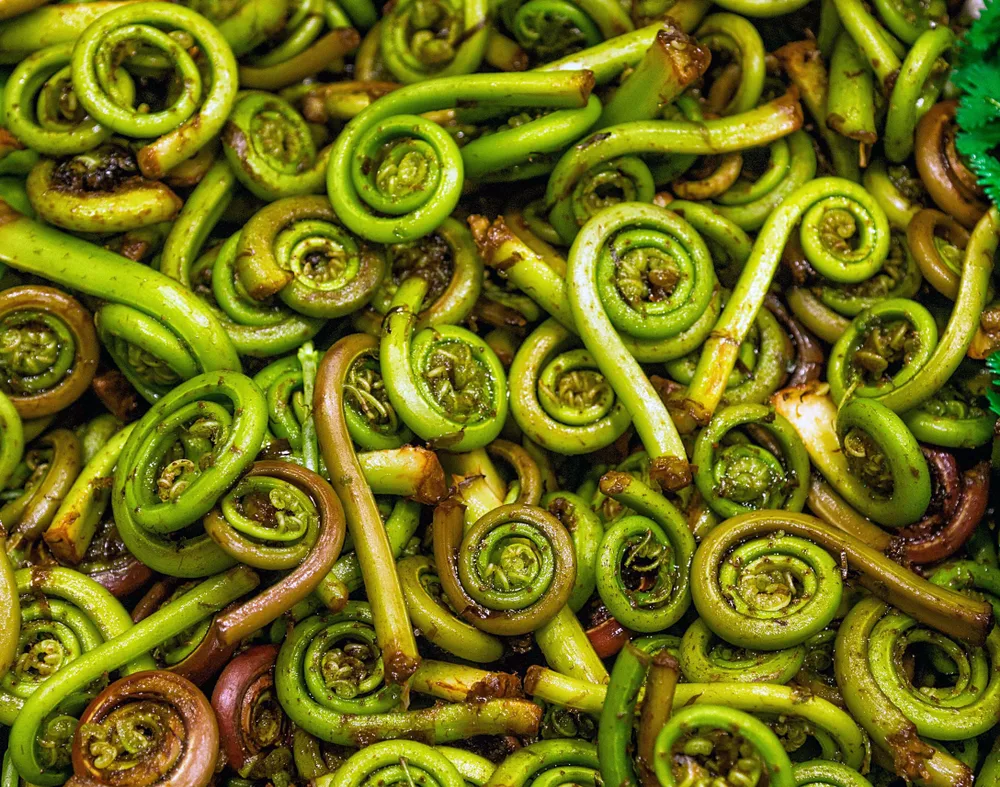
If you’re looking to grow your own ferns in your kitchen garden, or prefer to forage for your fiddlehead feast, we’ll discuss everything you need to know to take your ferns from forest to fork.
What Are Fiddleheads?
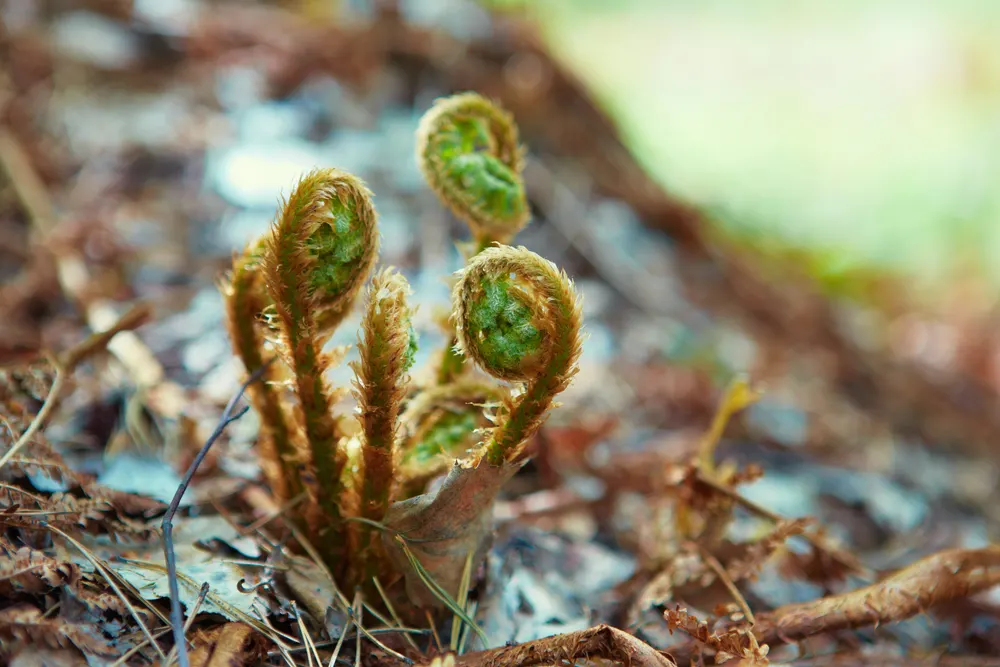
Before we go any further, let’s start with identifying edible ferns. In case you didn’t know, fiddleheads are young fern fronds. During their furled stage, they appear as shoots, poking up through the spring soil. More often than not, this furled stage only lasts a few days, leaving a very small harvesting window.
Generally, you have around a two-week window to pick fiddleheads. If this is your first year looking for them, or you’ve moved to a new area, it’s best to ask around to find out when you’re most likely to find them. Otherwise, you may miss them entirely.
The three most common edible fern species are bracken fern, lady fern, and ostrich fern.
Ostrich ferns are the most popular, considered the safest fern to eat. Plus, they have an interesting flavor profile. Ostrich ferns taste like a mixture of asparagus, green beans, and broccoli.
Bracken ferns tend to taste like almonds and asparagus, while lady ferns taste much like the ostrich variety, with notes of artichoke.
Identifying Edible Fiddleheads
Knowing how to identify fern varieties is important for safety reasons, as well as taste reasons. You wouldn’t want to pick a toxic fiddlehead. At the same time, picking one with the wrong flavor profile could lead to a disappointing meal.
Ostrich ferns are quite easy to spot, having two identifying characteristics. Firstly, they’ll have thin papery brown scales around the fiddleheads. This falls off as the fiddlehead unfurls. Secondly, a deep U-shaped groove is present on the inside of the otherwise smooth stem – think of the shape of a celery stalk, only smaller.
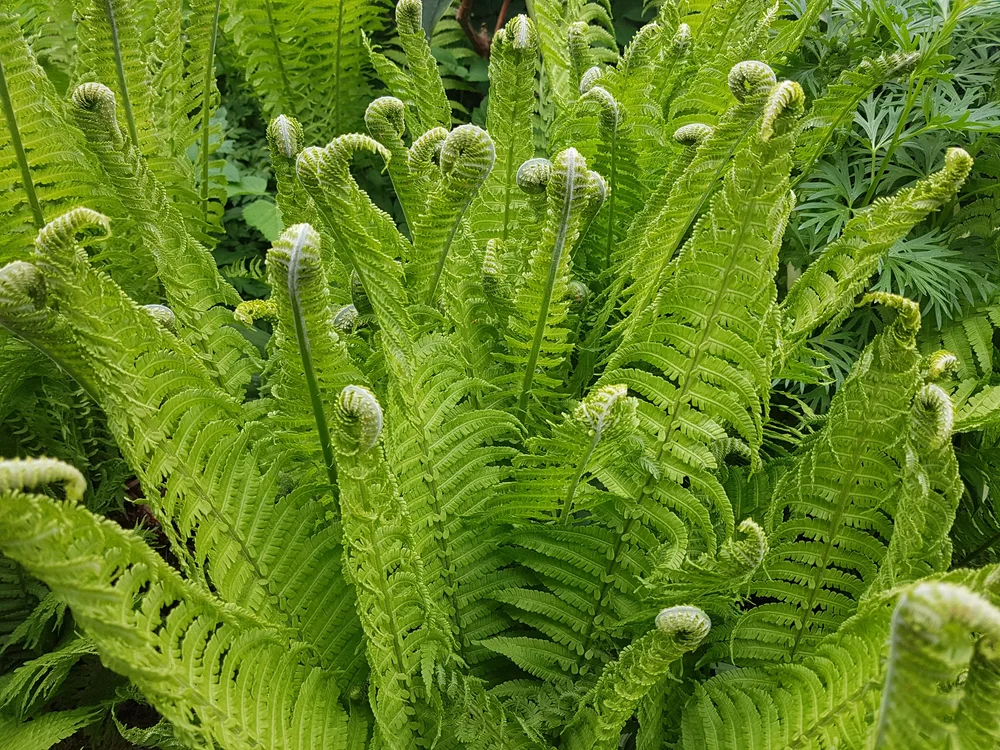
Bracken ferns don’t sport a noticeable groove or thin brown scales. Instead, you’ll notice they’re a little fuzzy. The biggest tell-tale sign of bracken ferns is their multiple little fiddleheads on a single stalk. These fronds uncoil into the larger leaves that bracken ferns are known for.
Lady ferns are trickier to spot because they’re quite similar to ostrich ferns. They both have U-shaped grooves and are covered in brown. The brown fuzz covering lady fern fiddles is much darker and stickier, resembling odd feathers instead of paper.
It’s important to note that many ferns are toxic – thoroughness when identifying ferns is advised.
If you are new to foraging, it is always best to go with someone experienced on your first few forays. A good field guide specific to your region is also advisable.
Care also needs to be taken when dealing with bracken fern fiddleheads. This species does contain high levels of carcinogens. Many suggest that only ostrich fern fiddleheads should be sauteed and served in a delicious meal, but bracken ferns are still edible in small quantities.
Here are a few other edible fiddle ferns to consider:
- Cinnamon Ferns: similar to ostrich ferns, but identifiable by their wooly covering and a flattened side instead of a groove. They are edible, but is is advised to cook them thoroughly and limit quantity due to possible side effects of nausea and dizziness.
- Royal Ferns: unique among edible fern varieties, with their stark pink stems. The fiddleheads are covered in brownish hairs.
Skip the Hunt and Still Enjoy This Foraging Favorite
Of course, if you don’t feel comfortable foraging fiddleheads on your own, or want to experience this favorite spring green without the hunt you can easily find them in farmer’s markets and nicer supermarkets each spring. They never last long, so grab them when you see them!
Growing Ferns at Home
Foraging isn’t for everyone. Luckily, growing ferns in your own backyard is not a difficult task. You probably have a couple already – whether indoors or in your shade garden.
Fiddlehead fern crowns are easy to come by, found at your local nursery, or you can simply order them online.
Planting Ferns
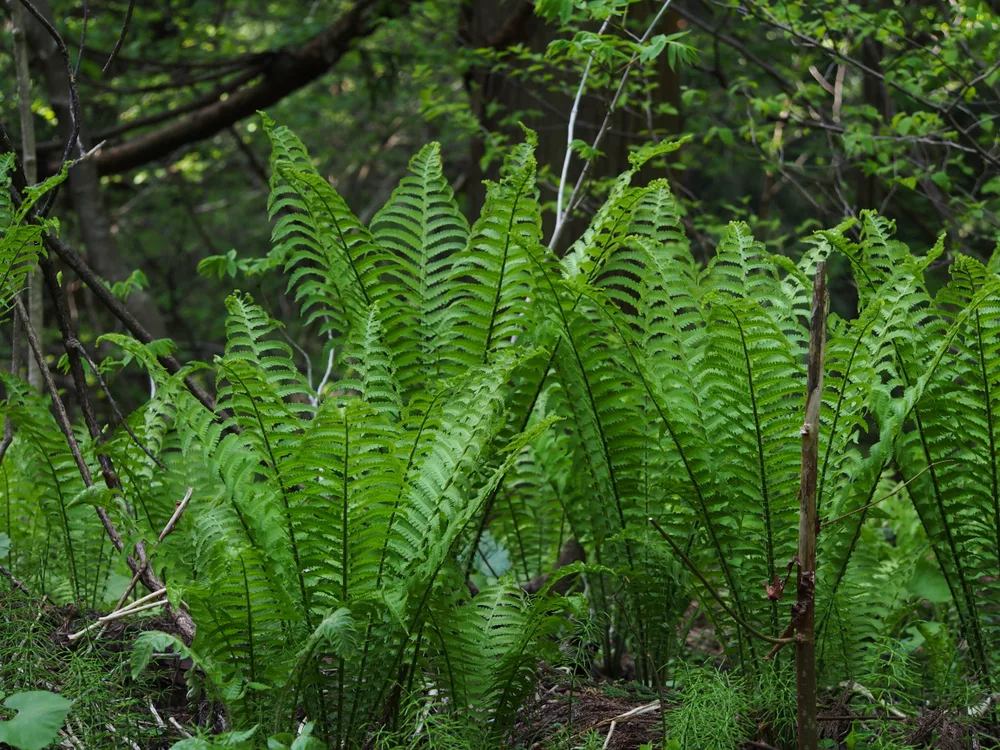
Ferns are best planted in early spring when winter and its biting frost have melted away.
Ferns have quite a large root ball, so giving them adequate space is very important. The general two feet apart rule when it comes to plants should suffice to keep your ferns nice and happy.
The planting hole should be as deep as its root ball, but twice as wide. Before you plant your fern in its new hole, gently shake off any old potting soil and place it in the hole. Water well and fill the hole with airy soil.
Ferns grow well in pots too, so long as they’re big enough.
Make sure the base of the pot has sufficient drainage. Fill with soil combined with some added coconut husk or perlite, which aids aeration.
Before you plant the fern, gently loosen its root system and shake off old soil. Plant your fern, making sure its root ball is no less than two inches below the rim. Fill the gaps with soil and press down gently to secure in place.
Whether you’re planting in the ground or pots, you’ll need to water them thoroughly after planting.
Caring For Ferns
When it comes to light, ferns aren’t too phased. Although they do prefer full shade, a few hours of partial sunlight won’t bother them as long as the soil stays moist.
Speaking of soil, it should be well-draining soil, slightly acidic and rich in humus.
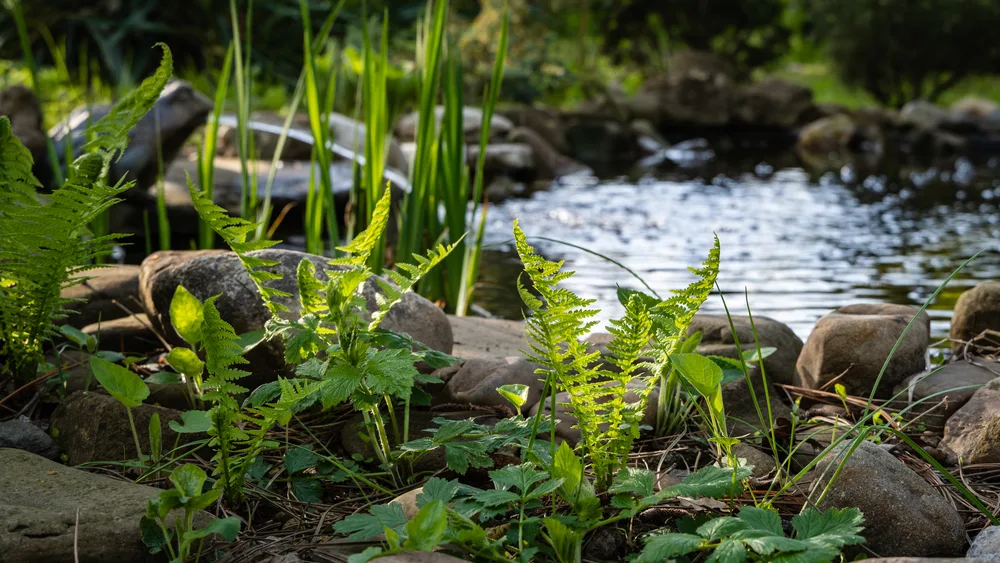
Ferns grow best in USDA zones 2 -7 and they need quite a bit of water. This is no surprise considering ferns naturally thrive in heavily wooded forests and near wetlands. Their soil, therefore, should never dry out.
If you live in warmer, drier climates, extra watering may be needed. A good, thick mulch around the base of your ferns helps retain moisture. Scorched leaves are a sure-fire sign that your fern isn’t getting enough water.
As much as they need humus-rich soil, extra fertilizer isn’t a must. A small bit of slow-release plant feed or compost is all you’ll need during spring. Before you add anything extra to your soil, always perform a soil test to see what it could be missing, if anything.
Ensure that your variety is safe to have in your garden. It might be edible for you, but highly toxic for pets. The bracken fern is a prime example of this.
Beware of slugs and snails – they enjoy nibbling on fiddleheads and are attracted by the moist soil that surrounds the ferns. Simple snail traps should keep them at bay. Try making your own beer trap by digging a bucket into the soil and filling it with beer. The snails are attracted to it and will fall in the bucket, far away from your ferns.
Lindsay has you covered with 8 Natural Ways To Stop Slugs & Snails Destroying Your Plants.
Harvesting Ferns
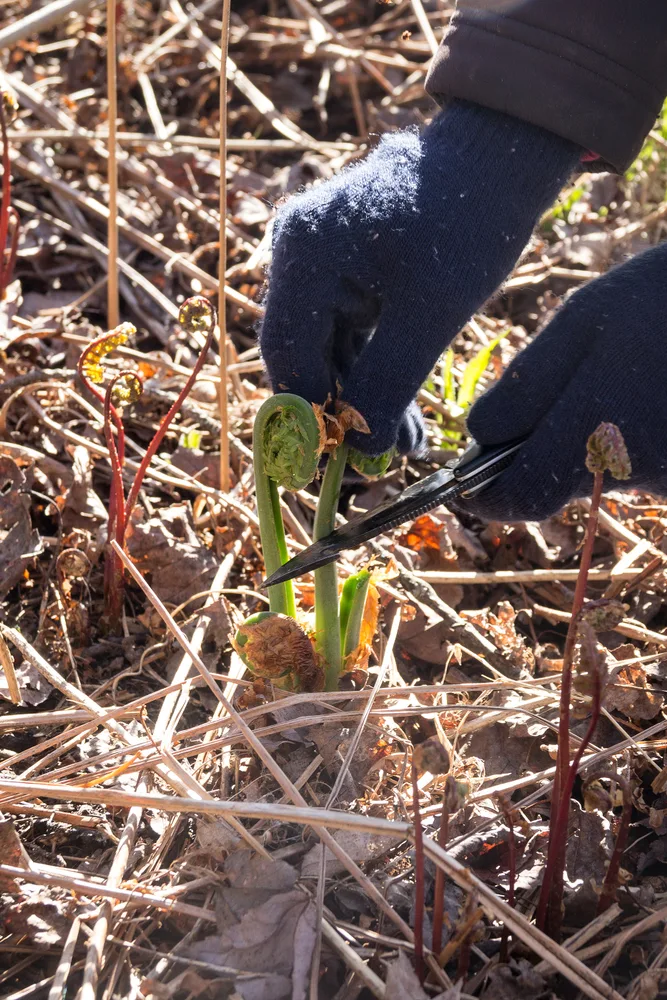
Unfortunately, for those growing ferns to eat them, you’ll need to wait for them to become established before you can begin harvesting. This could take a few years. Luckily, they make great ornamental plants in the meantime.
The best time to pick fiddleheads is in early spring when they’re still very young. As ferns mature and unfurl, they become toxic and bitter, not suitable for eating.
They’re just right when they’ve grown about two inches above the ground, just before or just as the fronds begin to unfurl. This happens within a few days, so the harvesting window is very small.
You’ll need to keep a close eye on your ferns and harvest your delicious fiddleheads as soon as possible.
Ostrich Ferns (and similar varieties)
Simply cut or snap the fiddleheads off at the crown with a sharp knife or gloved hands. Pick no more than half the amount of fiddleheads present on the crown. Taking more than half damages the plant, sometimes even killing it.
Remove its brown covering by placing the fiddleheads in a paper bag and gently shaking it.
Bracken ferns (and similar varieties)
Harvesting bracken fern fiddleheads are very similar to the ostrich varieties. Instead of snapping off each curled frond, you cut the stalk to which they’re attached. You can harvest these fiddleheads when their stalks are as long as five inches or even as short as one.
Cut or snap the stalk where it bends or breaks easily. Generally, a hearty, clean snap like asparagus stalks means you’ve got the right spot.
Always use clean containers and water when harvesting and cleaning off fiddleheads. Remember to practice good garden hygiene by cleaning your tools before and after your harvest.
Cleaning And Storing Fiddleheads
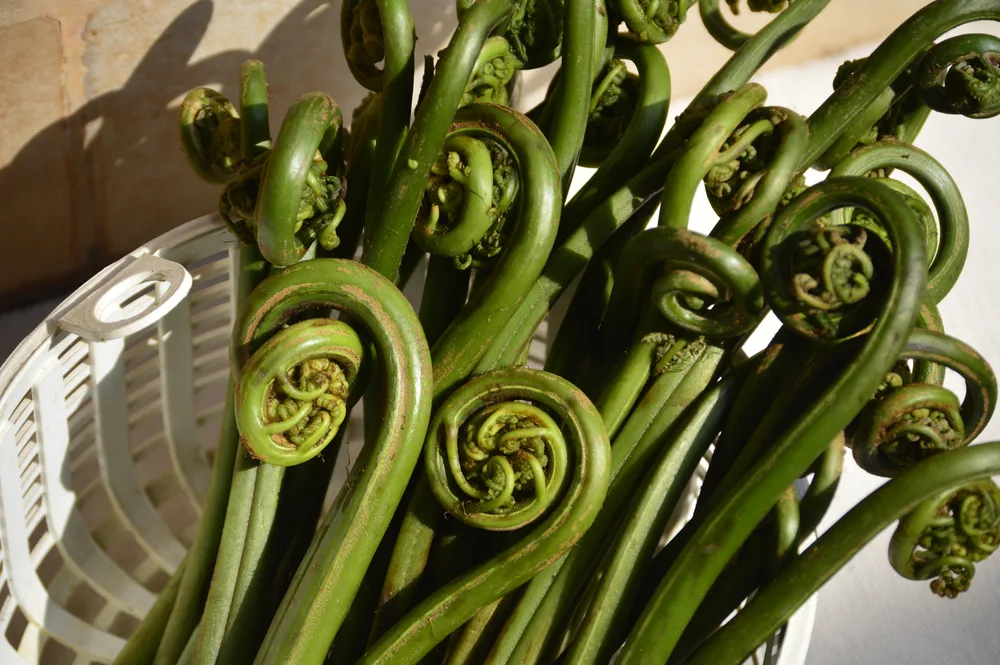
Now that you’ve got your fiddleheads, it’s time to clean them and store them for use in the kitchen.
The best way to clean them is to simply run them under cool water. For varieties with grooves, gently run a finger along the groove to clean away any hidden dirt. As an added measure, toss your fiddleheads into a colander and rinse them one more time.
Next, lay them on a plate or baking tray lined with a paper towel. Gently pat the sparkly clean fiddleheads.
Store your fiddleheads in a clean, airtight container in the fridge. You could also store them in a bowl of water, but you’ll need to change the water daily.
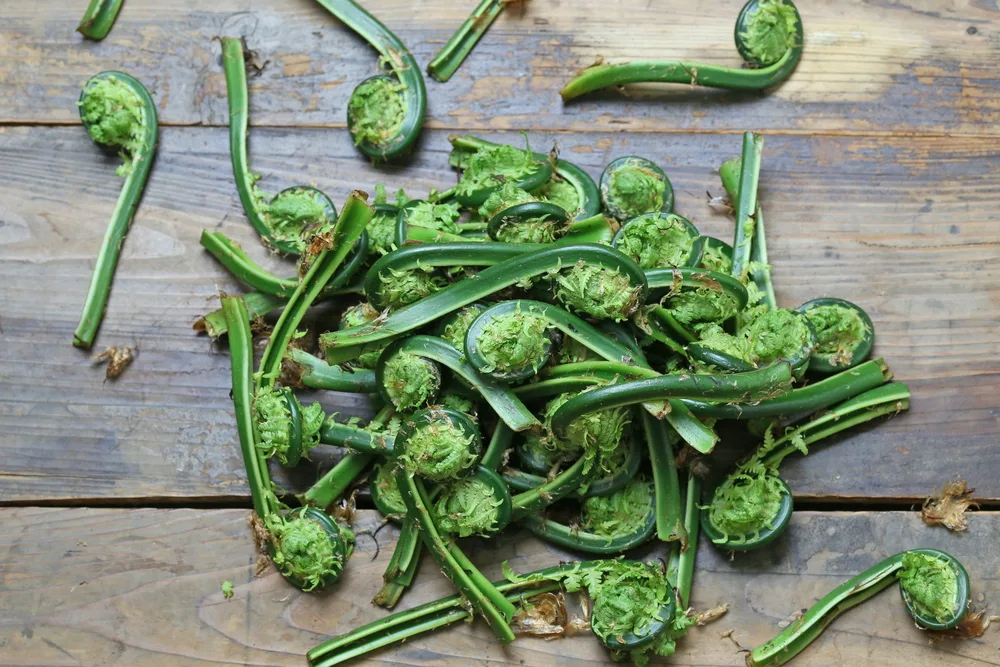
Fiddleheads can also be frozen for up to six months.
First, boil them for no less than two minutes. Then, rinse them under cool water to stop them from cooking and place them on a paper towel-lined baking tray to dry. Pop them into the freezer, tray, and all. Once frozen, move them to an airtight container.
If you’re going to use your fiddleheads immediately, trim off the darkened part of the stem before tossing them into your frying pan. Keep them on if they’re being stored and only cut them off before you cook them. This darkened section is just natural oxidation taking place after being snipped off the original plant.
Uses For Fiddleheads
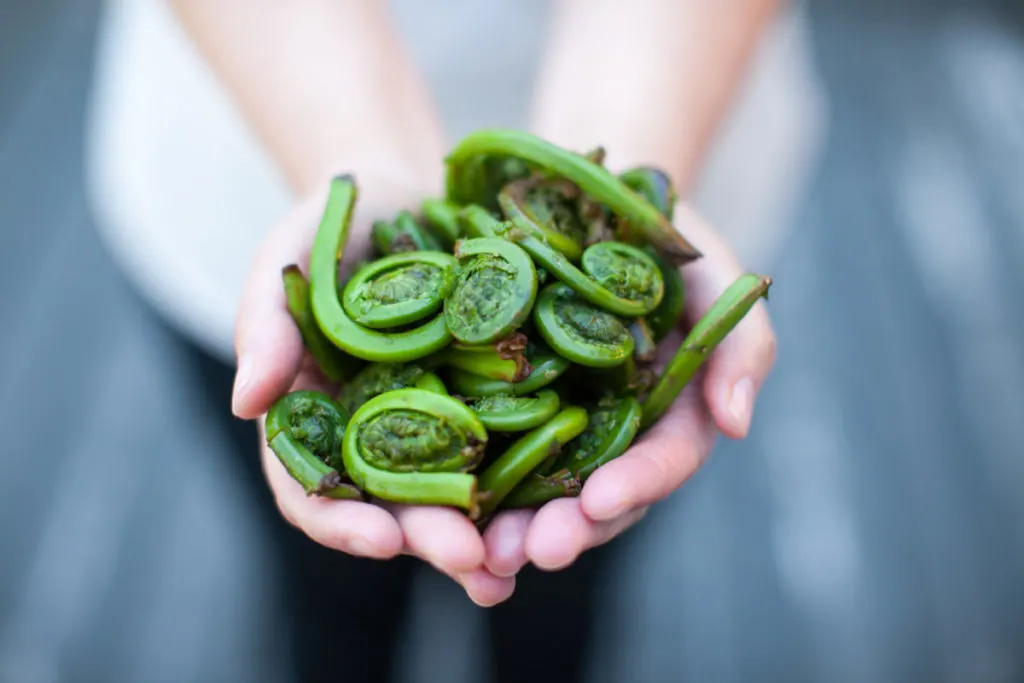
There are several uses for fiddlehead ferns. They’re extremely tasty and quite nutritious. They’re high in antioxidants, iron, potassium, and even omega-3 fatty acids. Their rich and interesting flavors add depth to meals and their uniqueness allows you to experiment in the kitchen.
1. Sautéed or Steamed Fiddleheads
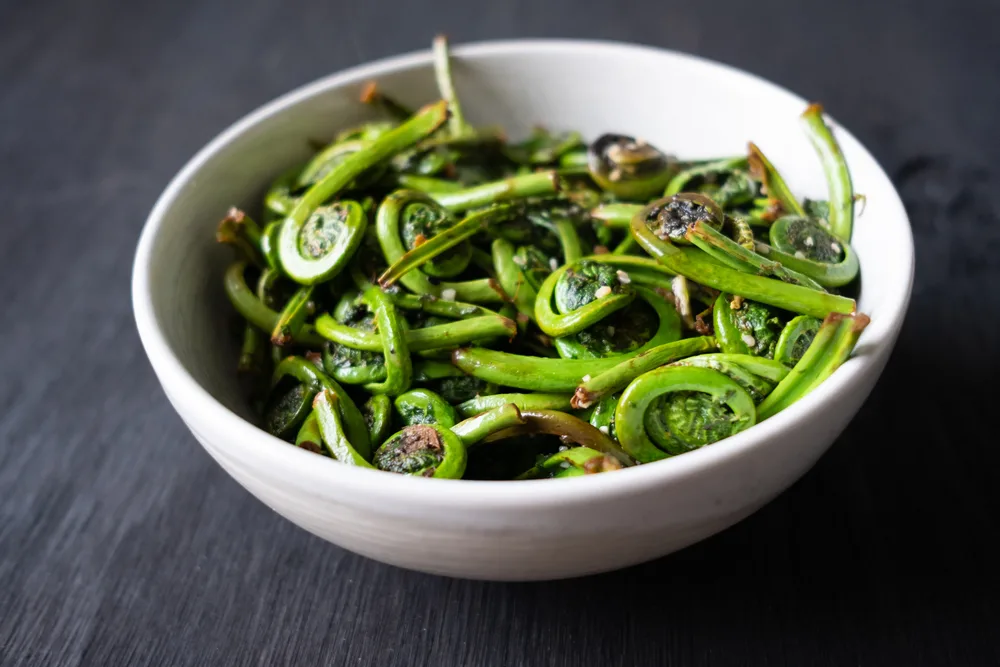
Whether steamed or sautéed, partially cooked fiddleheads with some melted butter are all you need for a simple, nutritious snack or dinner side.
For both, you’ll need…
- 1 pound of fiddleheads
- Sea salt (to taste)
Steamed
You’ll need…
- Butter (to taste)
- Black pepper (to taste)
For tasty steamed fiddleheads, first, remove the darkened parts of the stems and rinse. Then, bring some water to a boil in a large pot and pop your fiddleheads into a steamer basket or insert. Place the basket above the boiling water and close the lid. They’ll be perfectly tender, slightly crispy fiddleheads in as little as five minutes.
Strain them, drizzle some butter and sprinkle some salt.
Sautéed
You’ll need…
- 2 teaspoons butter, unsalted, or vegetable oil
- 1 thinly chopped clove of garlic
Sautéed fiddleheads take a little longer, but they’re just as tasty. Trim and rinse your fiddleheads (which you should do no matter which way you choose to cook fiddleheads).
First, blanch your fiddleheads in a large pot. Bring water to a boil, then add your salt and your fiddleheads and cook for one minute. Drain and rinse them with cold water to cool off.
Over medium heat, heat up the butter or oil, followed by the fiddleheads. Cook until browned, stirring frequently. Once the edges have browned, throw in the garlic. Keep stirring until the strong fragrance of the garlic wafts through your kitchen and its edges begin to color.
Throw in a bowl for a quick and easy lunch.
For some extra flavor, add some chili flakes or spritz some fresh lemon juice over it. Have some plain yogurt handy for a tasty complementary addition.
2. Pickled Fiddleheads
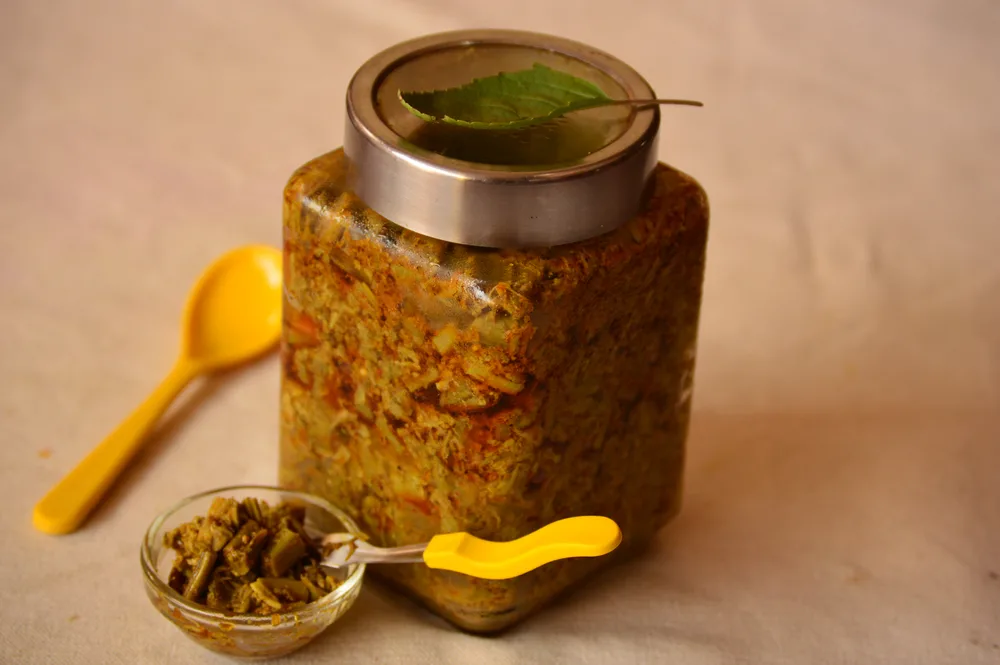
Fiddleheads store easily, whether in the fridge or freezer. But, some people understandably prefer pickling for ease of use and for flavor. Fiddleheads are easy to pickle, but it’s advised that you only preserve ostrich fern fiddleheads.
Pickled fiddleheads are particularly useful on cheese boards and beef up a pickle sandwich with ease. Or, of course, you could eat them straight out of the jar.
For the full recipe head over to The Spruce Eats.
3. Fiddleheads for breakfast
Fiddlehead omelets with some bacon are an adventurous way to spice up a basic breakfast.
For the filling, you’ll need…
- ½ a pound of fiddleheads
- About ½ a pound of diced bacon
- Half a finely chopped onion
- 1 tablespoon chives (to taste)
- Salt and pepper (to taste)
For the omelet, you’ll need…
- 12 eggs, lightly beaten
- ¼ cup of cream
- Finely chopped parsley (to taste)
- 2 tablespoons of butter
- A cup and a half of grated cheese (optional)
- Salt and pepper (to taste)
The Filling
Blanch the fiddleheads for two minutes, then rinse and cool. Next, fry up your bacon until crispy. Add the onion and fry until tender. Lastly, throw in your fiddleheads and chives and fry for a further minute or two.
The Omelet
Mix the eggs, cream, and parsley in a large bowl, adding salt and pepper to taste. In a hot skillet, melt some butter and pour in approximately ¼ of the egg mixture.
Just before the omelet is completely cooked, with the center still raw, add ¼ of the filling and cheese if you’d like. Fold. And repeat.
This recipe yields four delicious omelets.
3. Fiddlehead Pasta
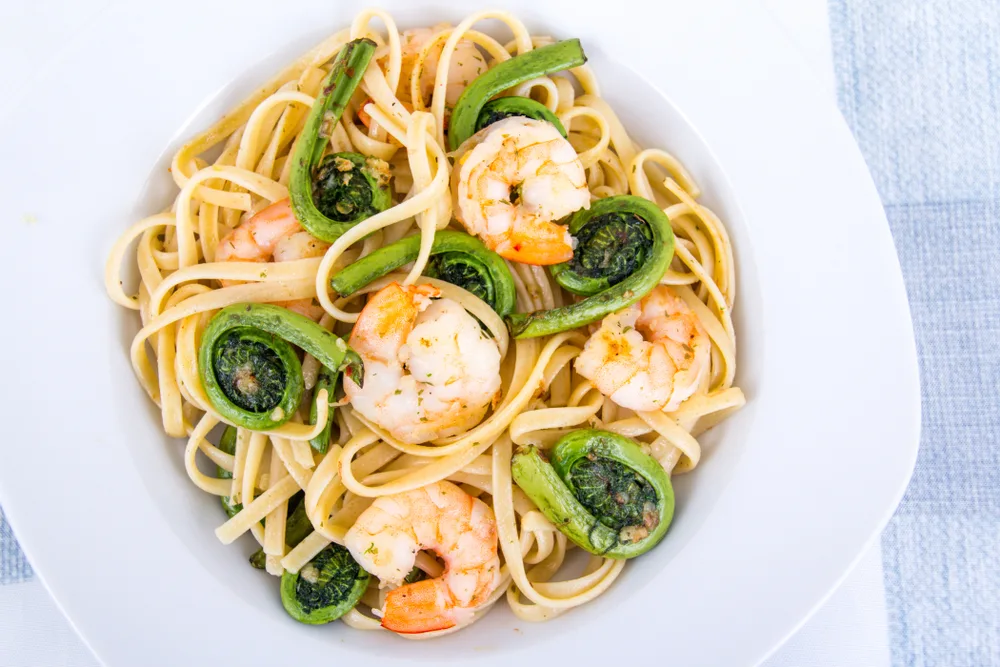
I love pasta, of all kinds. They’re my guilty pleasure and my ultimate comfort food. Carbonara is one of my all-time favorites – almost nothing improves on its simplicity. Except perhaps, fiddleheads.
Find the full recipe here.
4. Korean Delight
Bracken fern fiddleheads are on the list of edible ferns, but many caution against eating them, or at least monitoring how many bracken fern fiddleheads you eat. They’re extremely popular in Korea, popping up in many delicious Korean meals.
If you’re keen to try your hand at Korean cuisine, go ahead and check out this recipe at The Subversive Table.
Spring Eats
Fiddleheads are just one of many delicious spring edibles that can be foraged once the snow melts. It is truly amazing how much food pops up as things begin to warm.
Here are some more of our spring foraging articles:
Foraging Violets & Homemade Violet Syrup
Foraging, Eating And Preserving Ramsons (Wild Garlic)
Garlic Mustard – The Tastiest Invasive Species You Can Eat
Purple Dead Nettle: 12 Reasons To Pick This Early Spring Edible
25 Edible Wild Plants To Forage For In Early Spring

Get the famous Rural Sprout newsletter delivered to your inbox.
Including Sunday musings from our editor, Tracey, as well as “What’s Up Wednesday” our roundup of what’s in season and new article updates and alerts.

